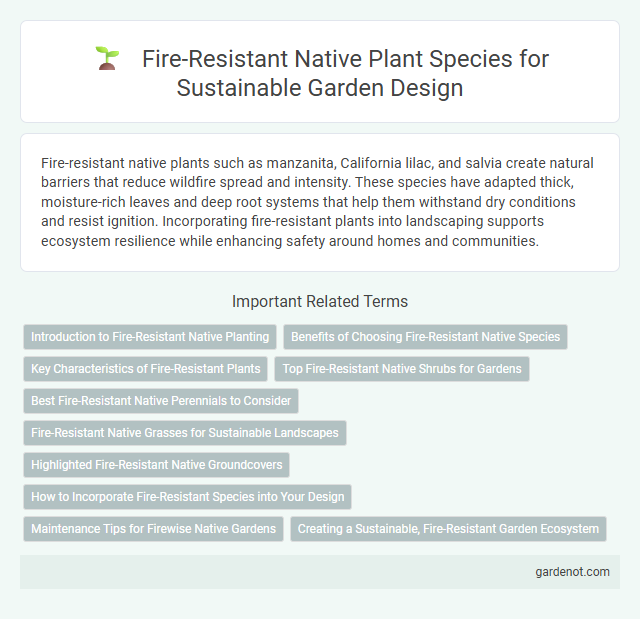Fire-resistant native plants such as manzanita, California lilac, and salvia create natural barriers that reduce wildfire spread and intensity. These species have adapted thick, moisture-rich leaves and deep root systems that help them withstand dry conditions and resist ignition. Incorporating fire-resistant plants into landscaping supports ecosystem resilience while enhancing safety around homes and communities.
Introduction to Fire-Resistant Native Planting
Fire-resistant native planting utilizes species naturally adapted to withstand and recover from wildfires, reducing property damage and promoting ecosystem resilience. Common fire-resistant plants include manzanita, ceanothus, and California lilac, which have high moisture content and low volatile oils in their leaves. Integrating these species into landscaping supports biodiversity and creates natural firebreaks to slow wildfire spread.
Benefits of Choosing Fire-Resistant Native Species
Fire-resistant native species reduce wildfire risk by containing moisture-rich foliage that slows fire spread. These plants support local ecosystems by providing habitat and food for native wildlife while enhancing landscape resilience. Choosing fire-resistant natives also minimizes the need for chemical treatments, promoting sustainable gardening practices.
Key Characteristics of Fire-Resistant Plants
Fire-resistant plants exhibit thick, moist, and waxy leaves that minimize flammability and slow fire spread. These species often contain high moisture content and low volatile oils, reducing ignition likelihood. Root systems tend to be deep and extensive, aiding quick recovery after fire events.
Top Fire-Resistant Native Shrubs for Gardens
Top fire-resistant native shrubs for gardens include Manzanita (Arctostaphylos spp.), known for its thick, waxy leaves that reduce flammability. Ceanothus (California lilac) offers dense, evergreen foliage with high moisture content, providing natural fire resistance. Toyon (Heteromeles arbutifolia) is another effective choice, with its leathery leaves and sturdy branches enhancing garden safety in fire-prone areas.
Best Fire-Resistant Native Perennials to Consider
Best fire-resistant native perennials include California fuchsia (Epilobium canum), which thrives in dry conditions and resists ignition due to its succulent leaves. Manzanita (Arctostaphylos spp.) offers not only fire resistance but also supports local wildlife with its evergreen foliage and berries. These species reduce fire risk while enhancing biodiversity and landscape resilience in fire-prone areas.
Fire-Resistant Native Grasses for Sustainable Landscapes
Fire-resistant native grasses such as blue grama (Bouteloua gracilis), buffalo grass (Bouteloua dactyloides), and little bluestem (Schizachyrium scoparium) provide sustainable landscaping solutions by reducing wildfire risk while supporting local ecosystems. These drought-tolerant species possess low oil content and high moisture retention, minimizing flammability and promoting soil health. Incorporating fire-resistant native grasses enhances landscape resilience, conserves water, and fosters biodiversity in fire-prone regions.
Highlighted Fire-Resistant Native Groundcovers
Highlighted fire-resistant native groundcovers such as Bearberry (Arctostaphylos uva-ursi), Creeping Mahonia (Mahonia repens), and Snow-in-Summer (Cerastium tomentosum) effectively reduce fire spread due to their low flammability and moisture retention. These species thrive in a variety of soil types, support local biodiversity, and offer excellent soil stabilization, making them ideal for fire-prone landscapes. Incorporating these native groundcovers into planting designs not only enhances fire resilience but also promotes ecological sustainability.
How to Incorporate Fire-Resistant Species into Your Design
Incorporate fire-resistant native species such as manzanita, oak, and ceanothus by grouping them strategically around structures to create defensible space and slow wildfire spread. Focus on selecting plants with high moisture content and low resin levels, ensuring proper spacing and regular maintenance to reduce fuel load. Integrate these species into landscape design with layered plantings and fire-resilient ground covers to enhance both aesthetic appeal and fire protection.
Maintenance Tips for Firewise Native Gardens
Fire-resistant native species such as manzanita, ceanothus, and California lilac require regular pruning to remove dead branches and enhance air circulation, reducing fuel for wildfires. Mulching with non-flammable materials like gravel instead of organic mulch limits ignition risk while retaining soil moisture. Consistent irrigation during dry periods maintains plant health and fire resistance, supporting a resilient Firewise garden ecosystem.
Creating a Sustainable, Fire-Resistant Garden Ecosystem
Fire-resistant native plant species such as manzanita, California lilac, and redbud play a crucial role in creating a sustainable garden ecosystem by reducing fire hazards through moisture retention and low resin content. Incorporating diverse drought-tolerant and fire-adaptive plants enhances soil stability and supports local wildlife while minimizing the spread of wildfires. Strategic placement and regular maintenance of these fire-resistant natives promote resilience and long-term sustainability in fire-prone landscapes.
Fire-resistant species Infographic

 gardenot.com
gardenot.com